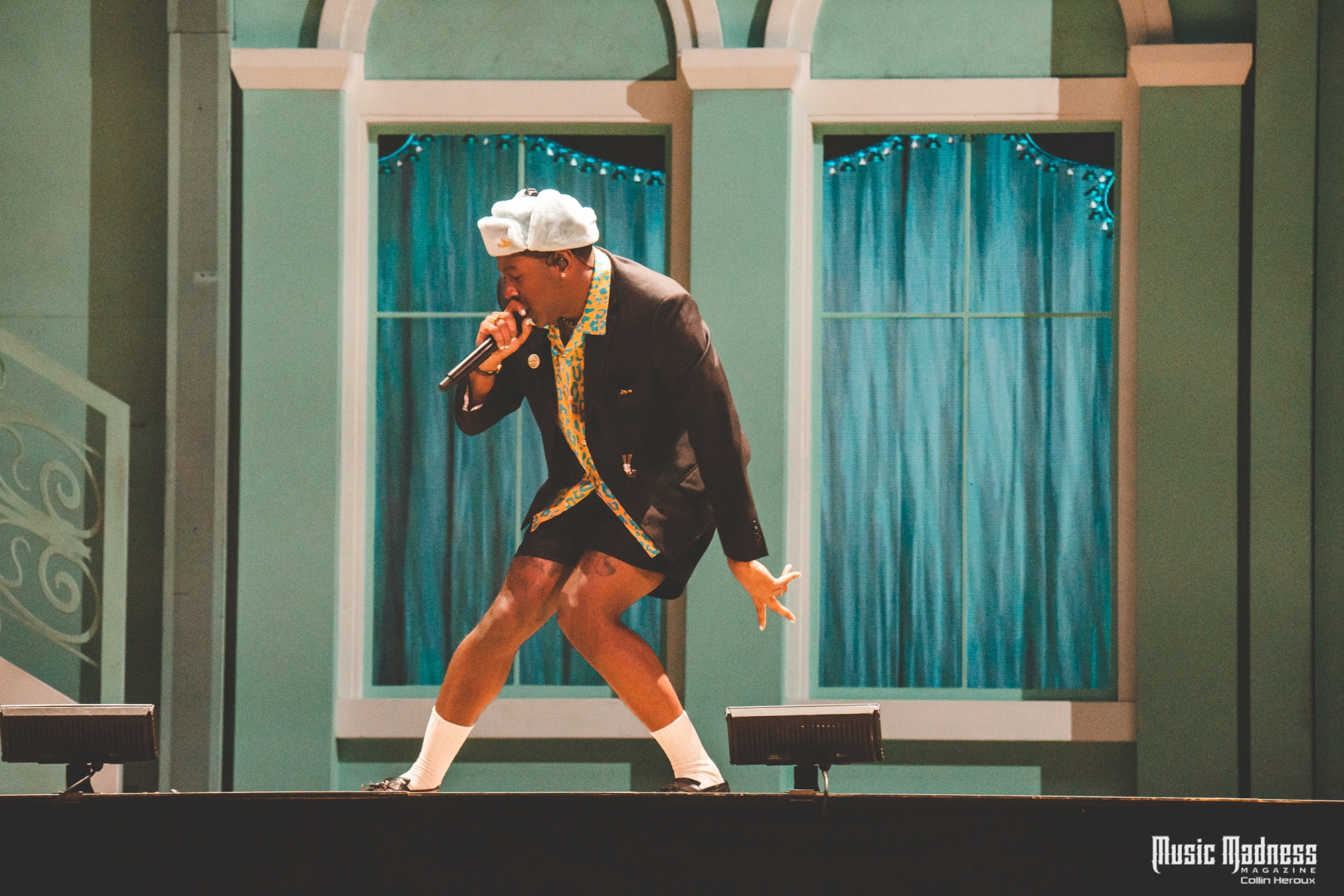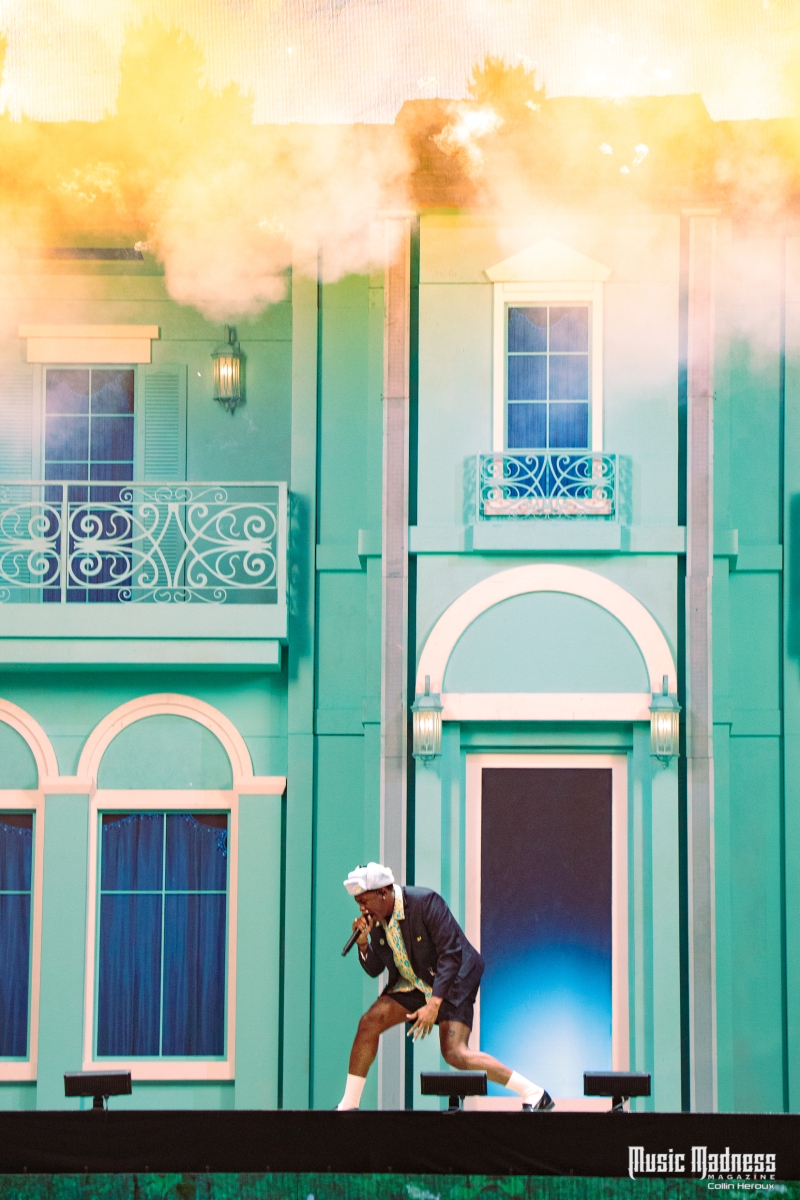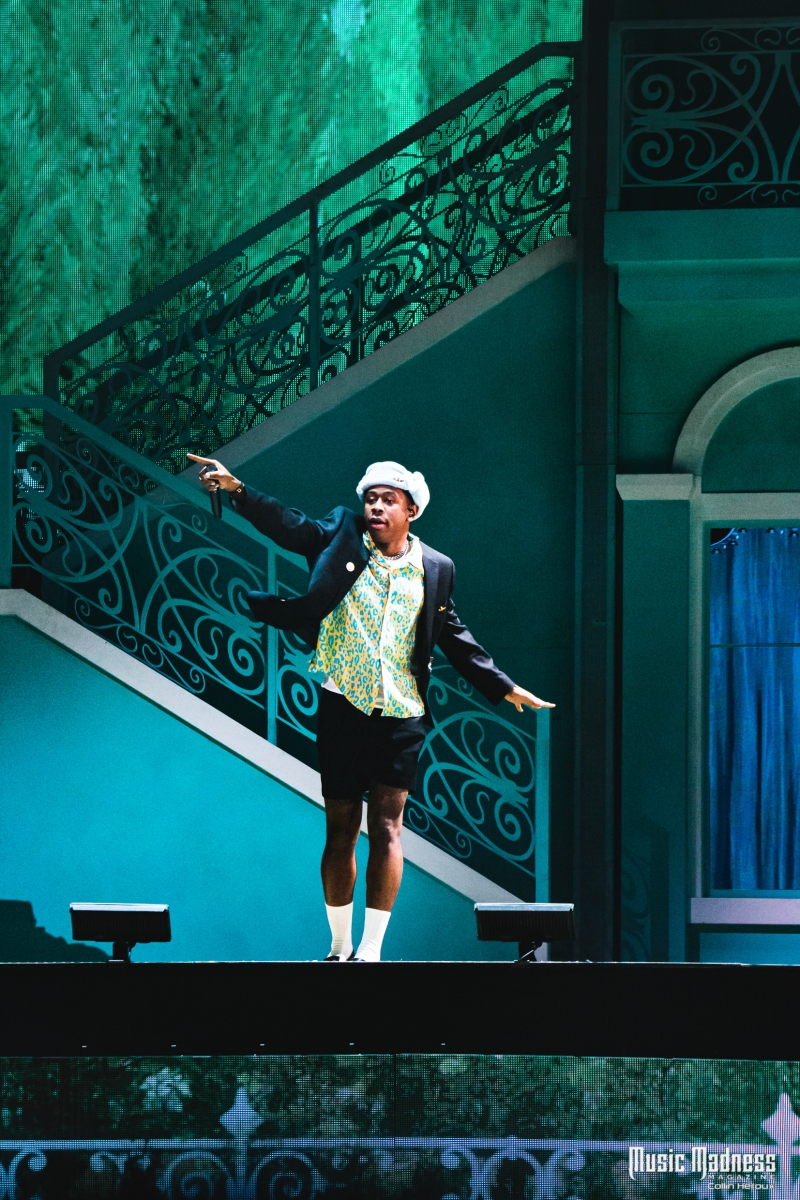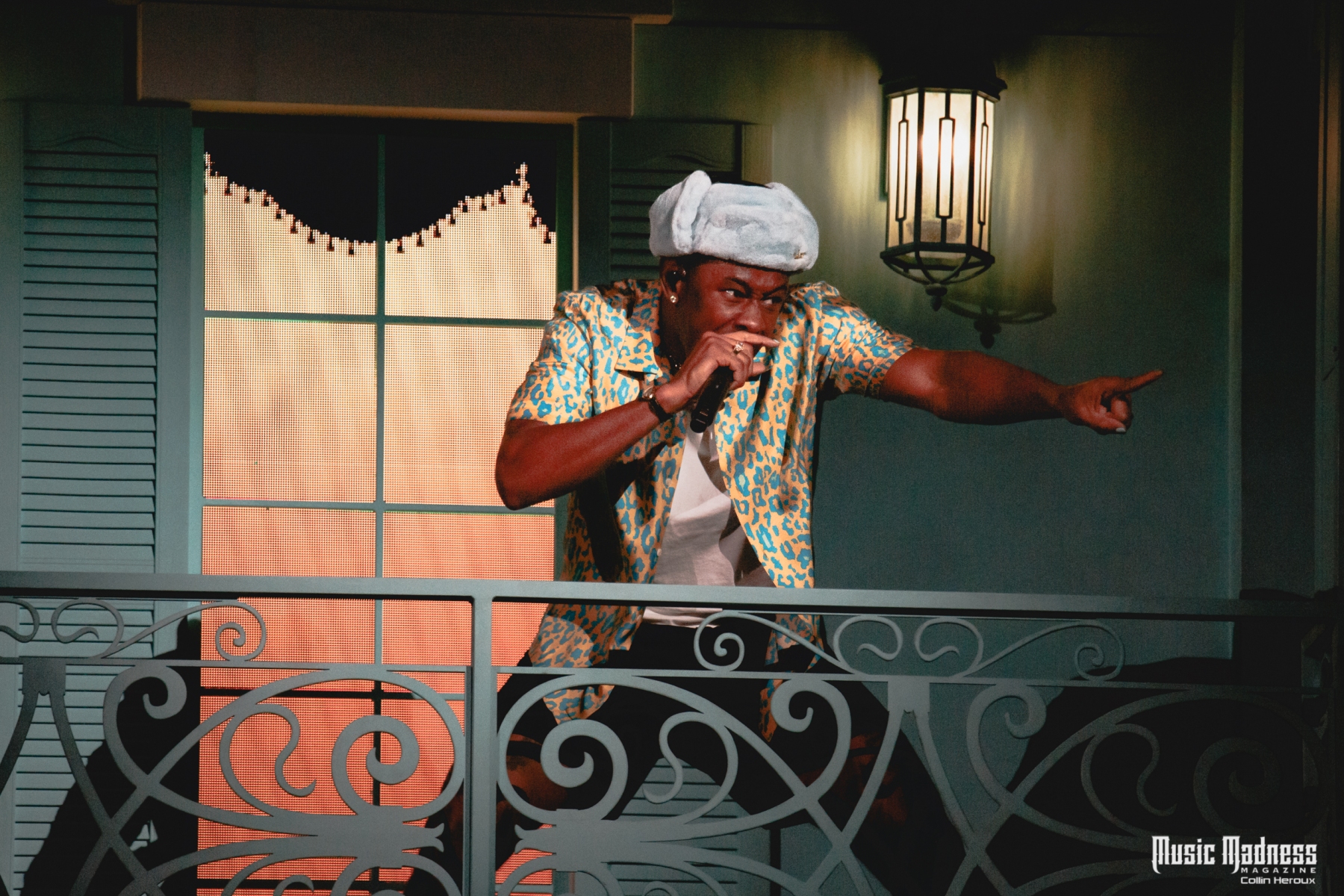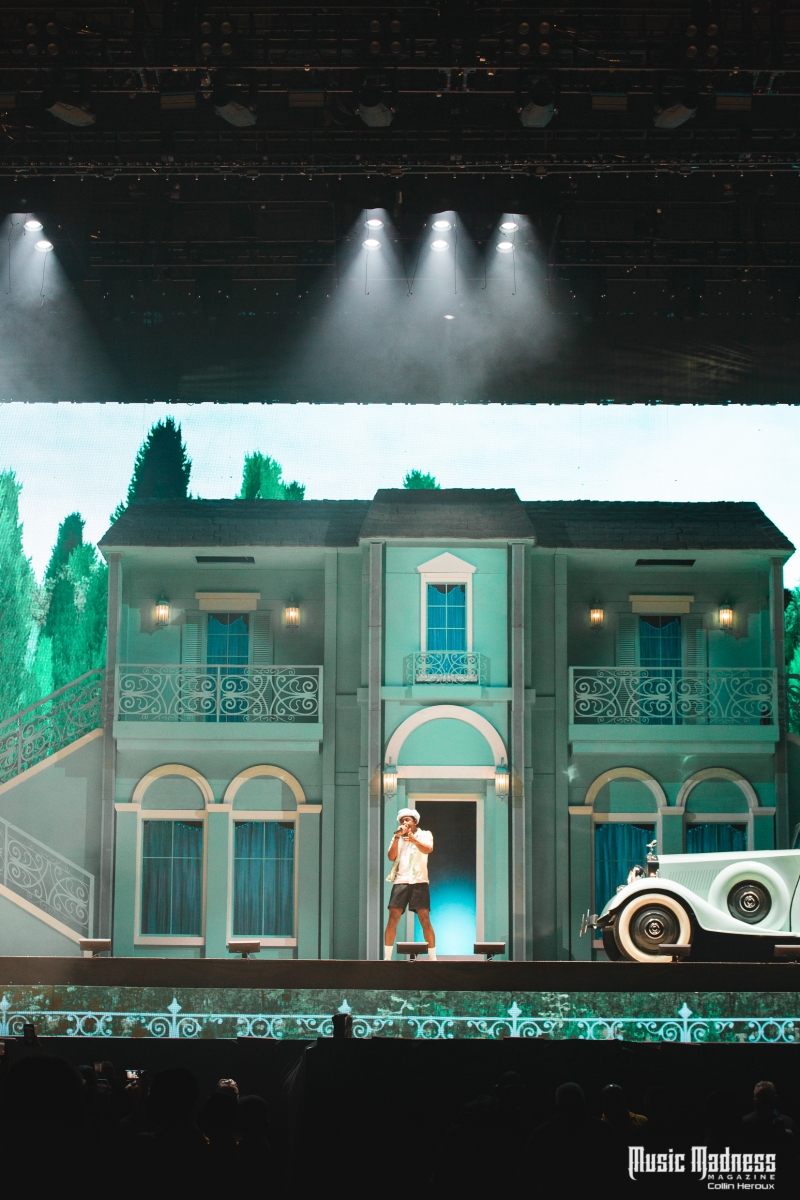
Wolf Haley. Ace. Igor. The Creator. Tyler Okonma has worn nearly as many faces during his career as a rap artist as he has albums, conjuring complex narratives and multiple personalities across his discography that have enhanced the artistic license with which he’s explored his life in his rise to stardom. Beginning as the de facto ringleader of the Odd Future collective, he’s now an accomplished solo artist with a Grammy win and a host of other accolades under his belt. Or perhaps it’s more fitting to imagine that those accolades live in the trunk of his Rolls-Royce, the chariot of his latest alter-ego, Tyler Baudelaire, the protagonist of Tyler’s latest record: Call Me If You Get Lost.
The thesis of the album is perhaps best summarized in the final stinger line from the track ‘BLESSED’ – “It’s opulence, baby!” Tyler’s live performance is a one-man show, but his playground for the night extends the entire length of the floor of Worcester’s DCU Center, encompassing two stages and, somewhat unpredictably, a boat. On the main stage is a massive pastel-blue mansion, built up to include a furnished balcony that Tyler can visit. The other is slightly smaller and full of tall, dry desert grasses, with a maze-like pattern in between the rows of faded greenery.
Tyler arrives to the stage in a Rolls, chauffeured by a man in a full suit. Tyler’s head is popping out of the top where he’s added a sunroof, and his valet opens the door and he ducks to pop out, wearing shorts and a black blazer, plus the trademark ushanka-style hat in which Baudelaire is always seen. The fireworks, both figuratively and literally, begin early on – ‘CORSO’ is an unstoppable force of a track that sets the scenery for the entirety of Call Me If You Get Lost, an album across which his success and luxurious lifestyle clash with reality that, despite all he has, Tyler (Baudelaire or Okonma) is missing something irreplaceable.
Even as hype man DJ Drama calls out an overarching narrative of Tyler traveling the world, including lounging on a yacht in Switzerland, Baudelaire insists he’s a bad person and alludes often to a tale of when he brushed up against the prospect of breaking up a relationship between a friend and that friend’s partner. Though it doesn’t make an appearance during the live show, the penultimate track of CMIYGL, ‘WILTSHIRE’, rips the curtain off of this incident, and it’s an exacting, nearly-nine-minute recounting that trails off with Tyler more speaking than rapping, seeming to still be grasping with his level of culpability.
But despite the weight of the subject matter poking through early on, the show is a riotous affair, and pyrotechnics rain a wall of sparks down upon the stage as Tyler performs. Though Tyler’s music has developed into something wild and varied over his career, incorporating elements of jazz, funk, noise, and just about everything else one can imagine at some point or another, the one constant of his oeuvre has always been a huge bass sound. The arena is alive and buzzing the whole night as much with the rumbling of the massive speakers trying to keep up with the low end of the EQ as it is with the cheers of fans who’ve packed the floor with encyclopedic knowledge of every single lyric.
After a trip to the balcony, Tyler takes a moment to greet the crowd and takes a stab at pronouncing “Worcester”, which results in a comedy of errors as the crowd tries to rate his attempts with varying levels of cheering and applause. Then, directing everyone’s attention to the car he arrived in, he asks someone in the audience, “You like my car? 1939 Wraith,” then prompts them to see if they know what make of car it is. They don’t, but it’s an easy segue for Tyler into lead single ‘LUMBERJACK’, which begins with the line, “Rolls-Royce pull up / Black boy hop out”.
It’s the type of braggadocio Tyler has always trafficked in, aged and classed-up like a fine wine but still rocking the immense bass. The image of a Black man, a young one at that, emerging from a car whose name is synonymous with the height of luxury is powerful and one imagines aspirational, Tyler having built himself from a relative unknown into a superstar on his journey from age twenty to thirty. It’s a lyrical scene designed to tweak the typical perception of wealth, which historically has been rather old and white. Throughout the song, Tyler goes to the rear of the car and pulls out two suitcases which he leaves just off-center in the stage.
Soon enough, the car itself descends on a platform into the bowels of the arena, and another vehicle entirely comes into play. Mounted on thick rails running the length of the “moat” in the center of the room is a large boat, and Tyler, helped by his valet once again, steps on and stands like a pirate, feet on the white seat of the red runabout. He performs ‘WUSYANAME’ as it stops dead center in the crowd, then as the track nears its conclusion he steps onto the bow and finishes the song, whipping around to each side to prompt the audience to sing along in turns.
Depositing him eventually on the other stage, the one with all the grass – some of the audience on the periphery of the pit have followed him to the other extreme of the arena; although by performing at both poles Tyler has solved one of the great conundrums of live music, removing the notion of a fixed front- and back-row. Turns out all you need to do that is a boat rigged on hydraulics. The change in stage marks a shift in the night where Tyler begins to look back. To infer some basic symbolism, he’s departed temporarily the mansion and opulence of Tyler Baudelaire, and he starts to examine some older material, beginning with a few tracks from 2017’s seminal Flower Boy, which marked a huge turning point in Tyler’s sound, career, and public persona. For a moment after this Tyler stops and talks for a bit, thinking about how he got signed at the age of nineteen, and remarking to the crowd, “The energy in here is fucking incredible, man.”
Rather than spend a massive chunk of time in the past, represented by this barren field, a time in which Tyler was seen as a much angrier, controversial figure in hip-hop, he chooses instead to blend many of his older cuts into a medley with abrupt transitions. Midway through this arrives ‘Yonkers’, and if you had a computer in 2011, you most definitely have heard this song and seen the video. It’s the one where he appears to eat a cockroach. Even if you didn’t seek it out, you no doubt encountered it on some news station with a chyron of conservative panic desperately making the case that Tyler, the Creator was the latest figure poisoning the youth. Tyler was actually temporarily banned from the UK for some of the lyrics hailing from his oldest pair of albums, Goblin and Bastard, though the ban expired after Theresa May became preoccupied plunging the nation deeper into the quagmire of Brexit. As for his older material, Tyler ends up spending the longest time performing ‘Tamale’, a highlight from the third album in that initial trio, Wolf, that interpolates a sample of steel drums to a ridiculously exciting effect.
The boat ride back to the main stage and its mansion is notably more somber than the last trip, Tyler taking a seat and singing ‘I THOUGHT YOU WANTED TO DANCE’, a forlorn, almost ballad-like song that sees Baudelaire rejected by his flame and promising brokenheartedly to “save a dance” in the song’s conclusion. But the low mood doesn’t last for long, as he arrives back to the mansion spewing LED lights that herald the beginning of ‘Who Dat Boy’. Fire explodes from the stage throughout the song, its warmth extending to the nosebleeds, and the boat, still visible, rocks violently on its hydraulics as if being buoyed about on choppy seas – the attention to detail on that is impressive, and it’s been matching the cadence of each song for some time.
‘Who Dat Boy’ is one of the highlights of Flower Boy, and Tyler speaks a bit on that album after the song. He remembers it being nominated for a Grammy but not winning, and vowing to his mom and entourage in the elevator afterward that he wouldn’t let that happen again. This moment was the impetus for his next album, the Grammy-winning IGOR, another record that charts Tyler and his eponymous shadow self in a separate love triangle, Tyler competing for the affections of a man who’s being torn in two directions. At the height of ‘EARFQUAKE’, Tyler returns to the balcony of the mansion, and for a moment he pauses, not even feeling the need to sing. Here he is, at the height of his career thus far, surveying from his perch as a crowd of thousands sings back his words. And this happens every night of the tour. Tyler’s show is defined by his singular status on stage: one man commanding an entire arena, willing his vision into the world on a massive scale. Everyone in the crowd is listening to his beats; they’re rapping his bars. It’s no easy feat, but he does it with aplomb.
Tyler takes a puff from a bright red inhaler and launches into ‘NEW MAGIC WAND’, culminating in a violent scream that sees him remove his hat for the first time and fall to the floor of the stage on his back. The final cut for the evening is ‘RUNITUP’, beginning with what he calls “victory horns” as he makes one last attempt to nail the pronunciation of “Worcester”. As the name suggests it’s one parting nod to that trademark Tyler Baudelaire opulence. Run it up – he’s got money to burn. Tyler thanks the crowd, and a lone spotlight follows him back to those suitcases he put down so early on. He walks with them through the front door of the mansion, off stage, and into whatever form he will take next.
Review and Photos by Collin Heroux








